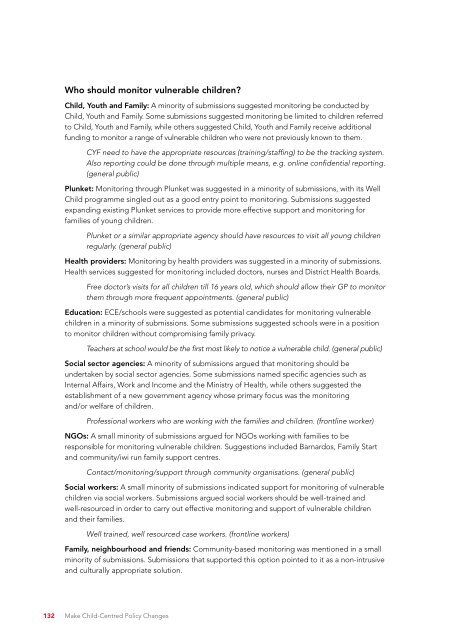The Green Paper for Vulnerable Children - Ministry of Social ...
The Green Paper for Vulnerable Children - Ministry of Social ...
The Green Paper for Vulnerable Children - Ministry of Social ...
You also want an ePaper? Increase the reach of your titles
YUMPU automatically turns print PDFs into web optimized ePapers that Google loves.
Who should monitor vulnerable children?Child, Youth and Family: A minority <strong>of</strong> submissions suggested monitoring be conducted byChild, Youth and Family. Some submissions suggested monitoring be limited to children referredto Child, Youth and Family, while others suggested Child, Youth and Family receive additionalfunding to monitor a range <strong>of</strong> vulnerable children who were not previously known to them.CYF need to have the appropriate resources (training/staffing) to be the tracking system.Also reporting could be done through multiple means, e.g. online confidential reporting.(general public)Plunket: Monitoring through Plunket was suggested in a minority <strong>of</strong> submissions, with its WellChild programme singled out as a good entry point to monitoring. Submissions suggestedexpanding existing Plunket services to provide more effective support and monitoring <strong>for</strong>families <strong>of</strong> young children.Plunket or a similar appropriate agency should have resources to visit all young childrenregularly. (general public)Health providers: Monitoring by health providers was suggested in a minority <strong>of</strong> submissions.Health services suggested <strong>for</strong> monitoring included doctors, nurses and District Health Boards.Free doctor’s visits <strong>for</strong> all children till 16 years old, which should allow their GP to monitorthem through more frequent appointments. (general public)Education: ECE/schools were suggested as potential candidates <strong>for</strong> monitoring vulnerablechildren in a minority <strong>of</strong> submissions. Some submissions suggested schools were in a positionto monitor children without compromising family privacy.Teachers at school would be the first most likely to notice a vulnerable child. (general public)<strong>Social</strong> sector agencies: A minority <strong>of</strong> submissions argued that monitoring should beundertaken by social sector agencies. Some submissions named specific agencies such asInternal Affairs, Work and Income and the <strong>Ministry</strong> <strong>of</strong> Health, while others suggested theestablishment <strong>of</strong> a new government agency whose primary focus was the monitoringand/or welfare <strong>of</strong> children.Pr<strong>of</strong>essional workers who are working with the families and children. (frontline worker)NGOs: A small minority <strong>of</strong> submissions argued <strong>for</strong> NGOs working with families to beresponsible <strong>for</strong> monitoring vulnerable children. Suggestions included Barnardos, Family Startand community/iwi run family support centres.Contact/monitoring/support through community organisations. (general public)<strong>Social</strong> workers: A small minority <strong>of</strong> submissions indicated support <strong>for</strong> monitoring <strong>of</strong> vulnerablechildren via social workers. Submissions argued social workers should be well-trained andwell-resourced in order to carry out effective monitoring and support <strong>of</strong> vulnerable childrenand their families.Well trained, well resourced case workers. (frontline workers)Family, neighbourhood and friends: Community-based monitoring was mentioned in a smallminority <strong>of</strong> submissions. Submissions that supported this option pointed to it as a non-intrusiveand culturally appropriate solution.132 Make Child-Centred Policy Changes
















